Deck 15: Lipids: Structure and Function
Question
Question
Question
Question
Question
Question
Question
Question
Question
Question
Question
Question
Question
Question
Question
Question
Question
Question
Question
Question
Question
Question
Question
Question
Question
Question
Question
Question
Question
Question
Question
Question
Question
Question
Question
Question
Question
Question
Question
Question
Question
Question
Question
Question
Question
Question
Question
Question
Question
Question
Question
Question
Question
Question
Question
Question
Question
Question
Question
Question
Question
Question
Question
Question
Question
Question
Question
Question
Question
Question
Question
Question
Question
Question
Question
Question
Question
Question
Question
Question

Unlock Deck
Sign up to unlock the cards in this deck!
Unlock Deck
Unlock Deck
1/106
Play
Full screen (f)
Deck 15: Lipids: Structure and Function
1
Which type of lipids is involved in the body's inflammatory response?
A) triacylglycerol
B) phospholipid
C) glycolipid
D) steroid
E) eicosanoid
A) triacylglycerol
B) phospholipid
C) glycolipid
D) steroid
E) eicosanoid
eicosanoid
2
Which statement BEST describes the meaning of "saturated" as it relates to fatty acids?
A) Saturated means that the fatty acid is hydrated.
B) Saturated means that the fatty acid is dissolved in water.
C) Saturated means that the fatty acid is bent or kinked.
D) Saturated means that the fatty acid has many carboxylic acids.
E) Saturated means that the fatty acid has the maximum number of hydrogens possible.
A) Saturated means that the fatty acid is hydrated.
B) Saturated means that the fatty acid is dissolved in water.
C) Saturated means that the fatty acid is bent or kinked.
D) Saturated means that the fatty acid has many carboxylic acids.
E) Saturated means that the fatty acid has the maximum number of hydrogens possible.
Saturated means that the fatty acid has the maximum number of hydrogens possible.
3
Which of the following is NOT a purpose of the cell membrane?
A) to communicate with chemical messengers
B) to separate the contents of the cell from external fluids
C) to facilitate transport of nutrients and waste
D) to synthesize proteins
E) to protect the contents of the cell from undesirable chemicals
A) to communicate with chemical messengers
B) to separate the contents of the cell from external fluids
C) to facilitate transport of nutrients and waste
D) to synthesize proteins
E) to protect the contents of the cell from undesirable chemicals
to synthesize proteins
4
Which statements BEST describes the purpose of triacylglycerols in the body?
A) Triacylglycerols are a reservoir of long-term energy.
B) Triacylglycerols are a reservoir of short-term energy.
C) Triacylglycerols are chemical messengers.
D) Triacylglycerols are the main components of cell walls.
E) Triacylglycerols are important components of our diet but do not have a purpose in the body.
A) Triacylglycerols are a reservoir of long-term energy.
B) Triacylglycerols are a reservoir of short-term energy.
C) Triacylglycerols are chemical messengers.
D) Triacylglycerols are the main components of cell walls.
E) Triacylglycerols are important components of our diet but do not have a purpose in the body.

Unlock Deck
Unlock for access to all 106 flashcards in this deck.
Unlock Deck
k this deck
5
The following molecule is a cerebroside.What characteristics does this molecule have? 
A) The molecule has a sphingosine backbone and a monosaccharide.
B) The molecule has a glycerol backbone and a galactose sugar.
C) The molecule contains an amine.
D) The molecule has a sphingosine backbone and a glucose sugar.
E) The molecule has a glycerol backbone and a glucose sugar.

A) The molecule has a sphingosine backbone and a monosaccharide.
B) The molecule has a glycerol backbone and a galactose sugar.
C) The molecule contains an amine.
D) The molecule has a sphingosine backbone and a glucose sugar.
E) The molecule has a glycerol backbone and a glucose sugar.

Unlock Deck
Unlock for access to all 106 flashcards in this deck.
Unlock Deck
k this deck
6
The component of a cell membrane shown below is 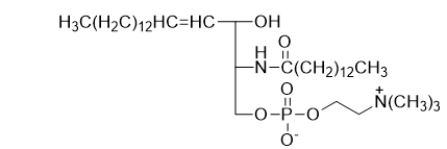
A) glycerophospholipid.
B) glycosphingolipid.
C) sphingomyelin.
D) triacylglycerol.
E) fatty acid.

A) glycerophospholipid.
B) glycosphingolipid.
C) sphingomyelin.
D) triacylglycerol.
E) fatty acid.

Unlock Deck
Unlock for access to all 106 flashcards in this deck.
Unlock Deck
k this deck
7
Which of the fatty acids shown below are saturated? 
A) stearic acid
B) stearic acid and palmitic acid
C) oleic acid, linoleic acid, and arachidonic acid
D) arachidonic acid
E) All of these are saturated.

A) stearic acid
B) stearic acid and palmitic acid
C) oleic acid, linoleic acid, and arachidonic acid
D) arachidonic acid
E) All of these are saturated.

Unlock Deck
Unlock for access to all 106 flashcards in this deck.
Unlock Deck
k this deck
8
Which of the fatty acids below is a solid at room temperature? 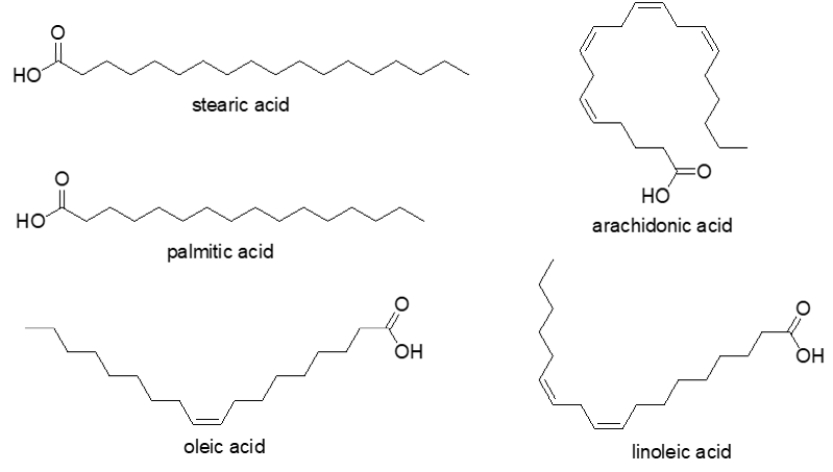
A) stearic acid
B) stearic acid and palmitic acid
C) oleic acid, linoleic acid, and arachidonic acid
D) arachidonic acid
E) None of these are solids at room temperature.

A) stearic acid
B) stearic acid and palmitic acid
C) oleic acid, linoleic acid, and arachidonic acid
D) arachidonic acid
E) None of these are solids at room temperature.

Unlock Deck
Unlock for access to all 106 flashcards in this deck.
Unlock Deck
k this deck
9
The component of a cell membrane shown below is a 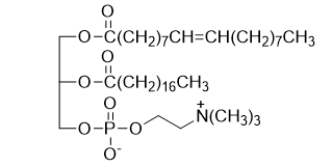
A) glycerophospholipid.
B) glycosphingolipid.
C) sphingomyelin.
D) triacylglycerol.
E) fatty acid.

A) glycerophospholipid.
B) glycosphingolipid.
C) sphingomyelin.
D) triacylglycerol.
E) fatty acid.

Unlock Deck
Unlock for access to all 106 flashcards in this deck.
Unlock Deck
k this deck
10
Which figure BEST illustrates how the lipid bilayer is normally arranged in a cell membrane? 
A) figure a
B) figure b
C) figure c
D) figure d
E) The bilayer would disintegrate.

A) figure a
B) figure b
C) figure c
D) figure d
E) The bilayer would disintegrate.

Unlock Deck
Unlock for access to all 106 flashcards in this deck.
Unlock Deck
k this deck
11
What type of lipid is this molecule? 
A) This is a triacylglycerol.
B) This is a glycerophospholipid.
C) This is a glycosphingolipid.
D) This is a sphingomyelin.
E) This is an ethanolamine.

A) This is a triacylglycerol.
B) This is a glycerophospholipid.
C) This is a glycosphingolipid.
D) This is a sphingomyelin.
E) This is an ethanolamine.

Unlock Deck
Unlock for access to all 106 flashcards in this deck.
Unlock Deck
k this deck
12
These steroid hormones are the major sex hormones.
A) glucocorticoids and mineralocorticoids
B) mineralocorticoids and progestins
C) estrogens and androgens only
D) estrogens, androgens, and progestins
E) All of these are sex hormones.
A) glucocorticoids and mineralocorticoids
B) mineralocorticoids and progestins
C) estrogens and androgens only
D) estrogens, androgens, and progestins
E) All of these are sex hormones.

Unlock Deck
Unlock for access to all 106 flashcards in this deck.
Unlock Deck
k this deck
13
Which of the following reactions illustrate the hydrolysis of triacylglycerols during digestion?
A)
B)
C)
D)
E) All of the above can occur.
A)

B)

C)

D)

E) All of the above can occur.

Unlock Deck
Unlock for access to all 106 flashcards in this deck.
Unlock Deck
k this deck
14
Which choice correctly numbers linolenic acid (shown below)using the omega system? 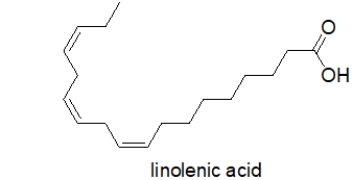
A) omega-9,12,15
B) omega-9
C) omega-3
D) omega-3,6,9
E) omega-9,12

A) omega-9,12,15
B) omega-9
C) omega-3
D) omega-3,6,9
E) omega-9,12

Unlock Deck
Unlock for access to all 106 flashcards in this deck.
Unlock Deck
k this deck
15
About how long do an average adult male's glycogen stores last?
A) about an hour
B) about a day
C) about a week
D) about a month
E) about 12 weeks
A) about an hour
B) about a day
C) about a week
D) about a month
E) about 12 weeks

Unlock Deck
Unlock for access to all 106 flashcards in this deck.
Unlock Deck
k this deck
16
Which choice correctly numbers linolenic acid (shown below)using the delta system? 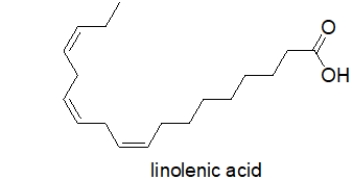
A) Δ9,12,15
B) Δ9
C) Δ3
D) Δ3,6,9
E) Δ9,12

A) Δ9,12,15
B) Δ9
C) Δ3
D) Δ3,6,9
E) Δ9,12

Unlock Deck
Unlock for access to all 106 flashcards in this deck.
Unlock Deck
k this deck
17
Which choice correctly numbers pinolenic acid (shown below)using the delta system? 
A) Δ5,9,12
B) Δ5
C) Δ6
D) Δ6,9,13
E) Δ9,12

A) Δ5,9,12
B) Δ5
C) Δ6
D) Δ6,9,13
E) Δ9,12

Unlock Deck
Unlock for access to all 106 flashcards in this deck.
Unlock Deck
k this deck
18
Anti-asthma medications are ________ inhibitors, whereas nonsteroidal anti-inflammatory drugs inhibit _________.
A) lipoxygenase; cyclooxygenase
B) phospholipase; cyclooxygenase
C) lipoxygenase; phospholipase
D) phospholipase; lipoxygenase
E) cyclooxygenase; phospholipase
A) lipoxygenase; cyclooxygenase
B) phospholipase; cyclooxygenase
C) lipoxygenase; phospholipase
D) phospholipase; lipoxygenase
E) cyclooxygenase; phospholipase

Unlock Deck
Unlock for access to all 106 flashcards in this deck.
Unlock Deck
k this deck
19
Blood is drawn from a patient to measure their "cholesterol levels".What is measured by this test?
A) the concentration of cholesterol in the blood
B) the concentration of cholesterol in the liver
C) the concentration of lipoproteins in the blood
D) bile acids
E) the concentration of all lipids in the blood
A) the concentration of cholesterol in the blood
B) the concentration of cholesterol in the liver
C) the concentration of lipoproteins in the blood
D) bile acids
E) the concentration of all lipids in the blood

Unlock Deck
Unlock for access to all 106 flashcards in this deck.
Unlock Deck
k this deck
20
Pain is often associated with inflammation.Why is this?
A) An injury that swells looks painful, thus tricking the injured into feeling pain.
B) Additional prostaglandins are released for the purpose of elevating pain levels.
C) Injury results in elevated prostaglandins, which results in sensitization of pain neurons.
D) Inflammation crowds organs and stretches skin, causing pain.
E) Broken skin causes pain.
A) An injury that swells looks painful, thus tricking the injured into feeling pain.
B) Additional prostaglandins are released for the purpose of elevating pain levels.
C) Injury results in elevated prostaglandins, which results in sensitization of pain neurons.
D) Inflammation crowds organs and stretches skin, causing pain.
E) Broken skin causes pain.

Unlock Deck
Unlock for access to all 106 flashcards in this deck.
Unlock Deck
k this deck
21
What important role does sphingomyelin have in the body?
A) It insulates nerve fibers in the brain.
B) It is important in energy storage.
C) It is a chemical messenger.
D) It is the primary component of the lipid bilayer for all cells.
E) It lines the stomach.
A) It insulates nerve fibers in the brain.
B) It is important in energy storage.
C) It is a chemical messenger.
D) It is the primary component of the lipid bilayer for all cells.
E) It lines the stomach.

Unlock Deck
Unlock for access to all 106 flashcards in this deck.
Unlock Deck
k this deck
22
Which choice correctly numbers pinolenic acid (shown below)using the omega system? 
A) omega-5,9.12
B) omega-5
C) omega-3
D) omega-6
E) omega-6,9,13

A) omega-5,9.12
B) omega-5
C) omega-3
D) omega-6
E) omega-6,9,13

Unlock Deck
Unlock for access to all 106 flashcards in this deck.
Unlock Deck
k this deck
23
Which of the following choices is the definition of amphipathic?
A) It refers to a molecule that can be both oxidized and reduced.
B) It refers to a molecule that reacts with its environment.
C) It refers to a molecule that has two reactive sites.
D) It refers to a molecule that makes bubbles.
E) It refers to a molecule that has a polar and a nonpolar part.
A) It refers to a molecule that can be both oxidized and reduced.
B) It refers to a molecule that reacts with its environment.
C) It refers to a molecule that has two reactive sites.
D) It refers to a molecule that makes bubbles.
E) It refers to a molecule that has a polar and a nonpolar part.

Unlock Deck
Unlock for access to all 106 flashcards in this deck.
Unlock Deck
k this deck
24
Which of the following is NOT a steroid?
A) insulin
B) androgens
C) estrogens
D) cholesterol
E) testosterone
A) insulin
B) androgens
C) estrogens
D) cholesterol
E) testosterone

Unlock Deck
Unlock for access to all 106 flashcards in this deck.
Unlock Deck
k this deck
25
Which fatty acid is an essential fatty acid?
A) stearic acid
B) palmitic acid
C) oleic acid
D) arachidonic acid
E) linoleic acid
A) stearic acid
B) palmitic acid
C) oleic acid
D) arachidonic acid
E) linoleic acid

Unlock Deck
Unlock for access to all 106 flashcards in this deck.
Unlock Deck
k this deck
26
Predict the order of melting point from lowest to highest for the fatty acids below. 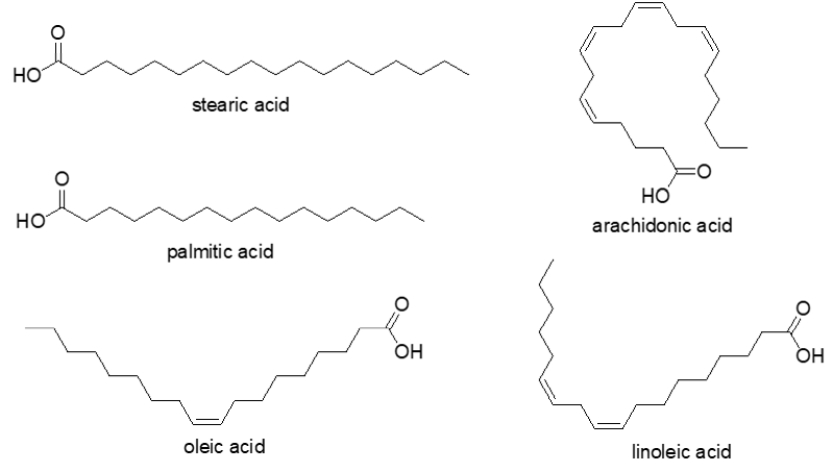
A) stearic < oleic < palmitic < arachidonic < linoleic
B) arachidonic < linoleic < oleic < palmitic < stearic
C) arachidonic < stearic < oleic < palmitic < linoleic
D) oleic < palmitic < arachidonic < linoleic < stearic
E) palmitic < stearic < oleic < arachidonic < linoleic

A) stearic < oleic < palmitic < arachidonic < linoleic
B) arachidonic < linoleic < oleic < palmitic < stearic
C) arachidonic < stearic < oleic < palmitic < linoleic
D) oleic < palmitic < arachidonic < linoleic < stearic
E) palmitic < stearic < oleic < arachidonic < linoleic

Unlock Deck
Unlock for access to all 106 flashcards in this deck.
Unlock Deck
k this deck
27
A membrane lipid is often depicted as shown below in lipid I.Which part of the molecular structure of lipid I does the circle represent? 
A) part A
B) part B
C) part C
D) parts A and B
E) parts B and C

A) part A
B) part B
C) part C
D) parts A and B
E) parts B and C

Unlock Deck
Unlock for access to all 106 flashcards in this deck.
Unlock Deck
k this deck
28
Which figure BEST illustrates how the lipid bilayer would arrange itself in a nonpolar solution, such as hexane? 
A) figure a
B) figure b
C) figure c
D) figure d
E) The bilayer would disintegrate.

A) figure a
B) figure b
C) figure c
D) figure d
E) The bilayer would disintegrate.

Unlock Deck
Unlock for access to all 106 flashcards in this deck.
Unlock Deck
k this deck
29
Which of the fatty acids below has the highest melting point? 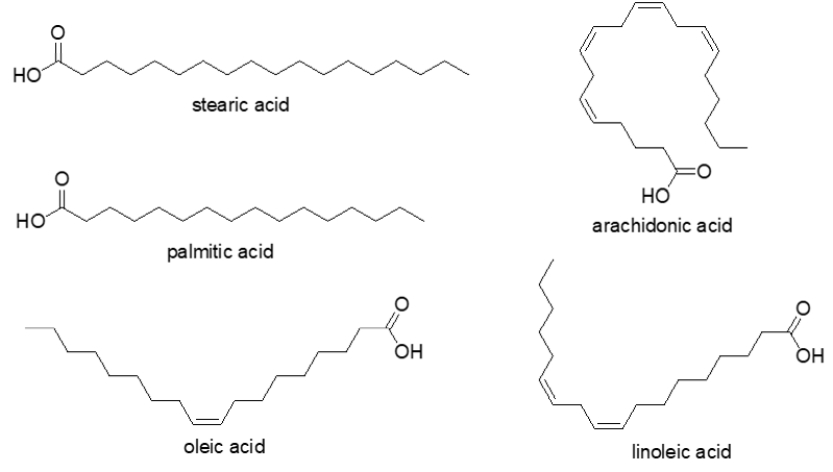
A) stearic acid
B) palmitic acid
C) oleic acid
D) arachidonic acid
E) linoleic acid

A) stearic acid
B) palmitic acid
C) oleic acid
D) arachidonic acid
E) linoleic acid

Unlock Deck
Unlock for access to all 106 flashcards in this deck.
Unlock Deck
k this deck
30
This lipoprotein is the largest and least dense.
A) chylomicron
B) VLDL
C) IDL
D) LDL
E) HDL
A) chylomicron
B) VLDL
C) IDL
D) LDL
E) HDL

Unlock Deck
Unlock for access to all 106 flashcards in this deck.
Unlock Deck
k this deck
31
Generally, membrane lipids
A) contain a hydroxyl group.
B) contain more than one ester functional group.
C) have a sphingosine backbone.
D) have a glycerol backbone.
E) have a nonpolar and a polar region.
A) contain a hydroxyl group.
B) contain more than one ester functional group.
C) have a sphingosine backbone.
D) have a glycerol backbone.
E) have a nonpolar and a polar region.

Unlock Deck
Unlock for access to all 106 flashcards in this deck.
Unlock Deck
k this deck
32
From what common molecule are all eicosanoids synthesized in the body?
A) cholesterol
B) any triacylglycerol
C) arachidonic acid
D) lipoproteins
E) any glycerophospholipid
A) cholesterol
B) any triacylglycerol
C) arachidonic acid
D) lipoproteins
E) any glycerophospholipid

Unlock Deck
Unlock for access to all 106 flashcards in this deck.
Unlock Deck
k this deck
33
Identify the class of lipid to which the following molecule belongs. 
A) eicosanoid
B) triacylglycerol
C) steroid
D) glycerophospholipid
E) fatty acid

A) eicosanoid
B) triacylglycerol
C) steroid
D) glycerophospholipid
E) fatty acid

Unlock Deck
Unlock for access to all 106 flashcards in this deck.
Unlock Deck
k this deck
34
The role of hormones in the body is to
A) regulate body temperature.
B) serve as a chemical messenger.
C) store energy.
D) catalyze chemical reactions.
E) transport key molecules.
A) regulate body temperature.
B) serve as a chemical messenger.
C) store energy.
D) catalyze chemical reactions.
E) transport key molecules.

Unlock Deck
Unlock for access to all 106 flashcards in this deck.
Unlock Deck
k this deck
35
Which statement BEST describes the importance of emulsification in fat digestion?
A) Emulsification breaks the fatty acids apart from glycerol, resulting in the absorption of the fat.
B) Emulsification is required to break up globules of insoluble fats so they can be hydrolyzed.
C) Emulsifiers are the molecules that actively transport fats into cells.
D) Emulsifiers transport fats through the bloodstream.
E) Emulsification transports electrons to lipase during hydrolysis.
A) Emulsification breaks the fatty acids apart from glycerol, resulting in the absorption of the fat.
B) Emulsification is required to break up globules of insoluble fats so they can be hydrolyzed.
C) Emulsifiers are the molecules that actively transport fats into cells.
D) Emulsifiers transport fats through the bloodstream.
E) Emulsification transports electrons to lipase during hydrolysis.

Unlock Deck
Unlock for access to all 106 flashcards in this deck.
Unlock Deck
k this deck
36
Which type of lipid is the main component of cell membranes?
A) triacylglycerols and steroids
B) eicosanoids and steroids
C) fatty acids and eicosanoids
D) phospholipids and glycolipids
E) triacylglycerols and eicosanoid
A) triacylglycerols and steroids
B) eicosanoids and steroids
C) fatty acids and eicosanoids
D) phospholipids and glycolipids
E) triacylglycerols and eicosanoid

Unlock Deck
Unlock for access to all 106 flashcards in this deck.
Unlock Deck
k this deck
37
An adipocyte stores
A) proteins.
B) triacylglycerols.
C) white blood cells.
D) red blood cells.
E) carbohydrates.
A) proteins.
B) triacylglycerols.
C) white blood cells.
D) red blood cells.
E) carbohydrates.

Unlock Deck
Unlock for access to all 106 flashcards in this deck.
Unlock Deck
k this deck
38
What type of lipid is this molecule? 
A) This is a triacylglycerol.
B) This is a glycerophospholipid.
C) This is a glycosphingolipid.
D) This is a sphingomyelin.
E) This is a cerebroside.

A) This is a triacylglycerol.
B) This is a glycerophospholipid.
C) This is a glycosphingolipid.
D) This is a sphingomyelin.
E) This is a cerebroside.

Unlock Deck
Unlock for access to all 106 flashcards in this deck.
Unlock Deck
k this deck
39
About how long do an average adult male's fat stores last?
A) about an hour
B) about a day
C) about a week
D) several weeks
E) several years
A) about an hour
B) about a day
C) about a week
D) several weeks
E) several years

Unlock Deck
Unlock for access to all 106 flashcards in this deck.
Unlock Deck
k this deck
40
Which of the following is NOT a side effect of anabolic steroid use?
A) infertility
B) testicular atrophy
C) cardiovascular disease
D) prostate cancer
E) excessive growth in teenagers
A) infertility
B) testicular atrophy
C) cardiovascular disease
D) prostate cancer
E) excessive growth in teenagers

Unlock Deck
Unlock for access to all 106 flashcards in this deck.
Unlock Deck
k this deck
41
This type of lipoprotein is often called "bad cholesterol."
A) chylomicron
B) VLDL
C) IDL
D) LDL
E) HDL
A) chylomicron
B) VLDL
C) IDL
D) LDL
E) HDL

Unlock Deck
Unlock for access to all 106 flashcards in this deck.
Unlock Deck
k this deck
42
Which statement BEST describes why VLDL is considered "bad cholesterol"?
A) It has the lowest density.
B) It is the largest lipoprotein.
C) It scavenges excess cholesterol and takes it to the liver.
D) It takes triacylglycerols to adipocytes.
E) It converts cholesterol into bile salts.
A) It has the lowest density.
B) It is the largest lipoprotein.
C) It scavenges excess cholesterol and takes it to the liver.
D) It takes triacylglycerols to adipocytes.
E) It converts cholesterol into bile salts.

Unlock Deck
Unlock for access to all 106 flashcards in this deck.
Unlock Deck
k this deck
43
How does an NSAID reduce pain?
A) It interacts directly with the pain receptors and deadens their response.
B) It damages inflammatory prostaglandins.
C) It inhibits the formation of inflammatory prostaglandins by inhibiting cyclooxygenase.
D) It fights infection and kills bacteria in the injury.
E) It reduces fever.
A) It interacts directly with the pain receptors and deadens their response.
B) It damages inflammatory prostaglandins.
C) It inhibits the formation of inflammatory prostaglandins by inhibiting cyclooxygenase.
D) It fights infection and kills bacteria in the injury.
E) It reduces fever.

Unlock Deck
Unlock for access to all 106 flashcards in this deck.
Unlock Deck
k this deck
44
These hormones regulate ion balances in tissues.
A) glucocorticoids
B) mineralocorticoids
C) progestins
D) androgens
E) estrogens
A) glucocorticoids
B) mineralocorticoids
C) progestins
D) androgens
E) estrogens

Unlock Deck
Unlock for access to all 106 flashcards in this deck.
Unlock Deck
k this deck
45
Amphipathic molecules can interact with both lipids and water because they contain
A) an ester.
B) sphingosine.
C) polar regions and nonpolar regions.
D) cholesterol.
E) saturated fatty acids.
A) an ester.
B) sphingosine.
C) polar regions and nonpolar regions.
D) cholesterol.
E) saturated fatty acids.

Unlock Deck
Unlock for access to all 106 flashcards in this deck.
Unlock Deck
k this deck
46
A polyunsaturated fatty acid contains multiple
A) ketones.
B) carboxylic acids.
C) carbon-carbon double bonds.
D) alcohols.
E) Any of the above is correct.
A) ketones.
B) carboxylic acids.
C) carbon-carbon double bonds.
D) alcohols.
E) Any of the above is correct.

Unlock Deck
Unlock for access to all 106 flashcards in this deck.
Unlock Deck
k this deck
47
The body uses _________ for short-term energy storage and _______ for long-term energy needs.
A) triacylglycerols; glucose
B) glucose; triacylglycerols
C) glycogen; triacylglycerols
D) glucose; glycogen
E) glycogen; glucose
A) triacylglycerols; glucose
B) glucose; triacylglycerols
C) glycogen; triacylglycerols
D) glucose; glycogen
E) glycogen; glucose

Unlock Deck
Unlock for access to all 106 flashcards in this deck.
Unlock Deck
k this deck
48
Select the set of lipids commonly found in cell membranes.
A) triacylglycerols, glycophospholipids, and cholesterol
B) triacylglycerols, glycerophospholipids.and cholesterol
C) cholesterol, glycophospholipids, and glycerophospholipids
D) triacylglycerols, glycophospholipids, and glycerophospholipids
E) fatty acids, triacylglycerols and glycerophospholipids
A) triacylglycerols, glycophospholipids, and cholesterol
B) triacylglycerols, glycerophospholipids.and cholesterol
C) cholesterol, glycophospholipids, and glycerophospholipids
D) triacylglycerols, glycophospholipids, and glycerophospholipids
E) fatty acids, triacylglycerols and glycerophospholipids

Unlock Deck
Unlock for access to all 106 flashcards in this deck.
Unlock Deck
k this deck
49
Which molecule represents the steroid nucleus?
A)
B)
C)
D)
E)
A)

B)

C)

D)

E)


Unlock Deck
Unlock for access to all 106 flashcards in this deck.
Unlock Deck
k this deck
50
Which biomolecules provide the MOST energy per gram?
A) proteins
B) carbohydrates
C) triacylglycerols
D) Protein and carbohydrates provide more energy than triacylglycerols.
E) Proteins, carbohydrates, and triacylglycerols provide the same amount of energy.
A) proteins
B) carbohydrates
C) triacylglycerols
D) Protein and carbohydrates provide more energy than triacylglycerols.
E) Proteins, carbohydrates, and triacylglycerols provide the same amount of energy.

Unlock Deck
Unlock for access to all 106 flashcards in this deck.
Unlock Deck
k this deck
51
The bar graph below shows the percentage of saturated fats in a variety of triacylglycerols.Given this information, which triacylglycerols should be minimized in the diet? 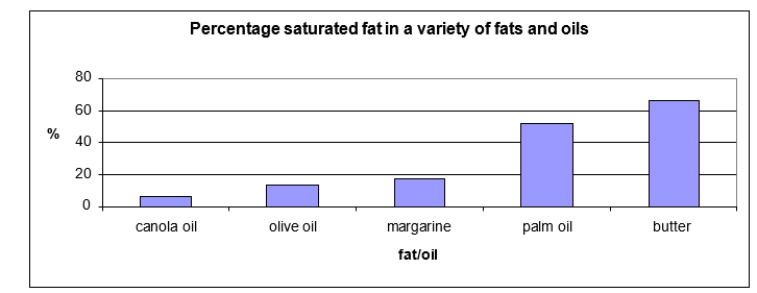
A) canola oil
B) butter
C) canola oil, olive oil, and margarine
D) margarine
E) palm oil and butter

A) canola oil
B) butter
C) canola oil, olive oil, and margarine
D) margarine
E) palm oil and butter

Unlock Deck
Unlock for access to all 106 flashcards in this deck.
Unlock Deck
k this deck
52
The melting point of a fatty acid is determined by _________in the fatty acid.
A) the number of hydrogen bonding functional groups
B) the number of double bonds
C) the number of carbons
D) both the number of carbons and the number of double bonds
E) the number of reactive functional groups
A) the number of hydrogen bonding functional groups
B) the number of double bonds
C) the number of carbons
D) both the number of carbons and the number of double bonds
E) the number of reactive functional groups

Unlock Deck
Unlock for access to all 106 flashcards in this deck.
Unlock Deck
k this deck
53
The molecule that facilitates transport through the cell is indicated by the letter____ in the following illustration of a cell membrane. 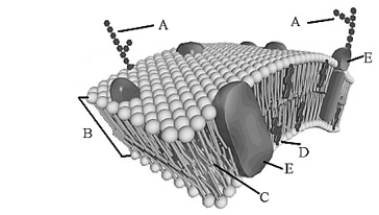
A) A
B) B
C) C
D) D
E) E

A) A
B) B
C) C
D) D
E) E

Unlock Deck
Unlock for access to all 106 flashcards in this deck.
Unlock Deck
k this deck
54
Lipid II contains which of the following functional groups not found in lipid I? 
A) amide
B) alcohol
C) alkene
D) amide and alcohol
E) amide, alcohol, and alkene

A) amide
B) alcohol
C) alkene
D) amide and alcohol
E) amide, alcohol, and alkene

Unlock Deck
Unlock for access to all 106 flashcards in this deck.
Unlock Deck
k this deck
55
Which of the following molecules are anabolic steroids? 
A) All of these are anabolic steroids.
B) Both II and III are anabolic steroids.
C) Only III is an anabolic steroid.
D) Both I and III are anabolic steroids.
E) None of these are anabolic steroids.

A) All of these are anabolic steroids.
B) Both II and III are anabolic steroids.
C) Only III is an anabolic steroid.
D) Both I and III are anabolic steroids.
E) None of these are anabolic steroids.

Unlock Deck
Unlock for access to all 106 flashcards in this deck.
Unlock Deck
k this deck
56
The portion of the molecule that is boxed is called 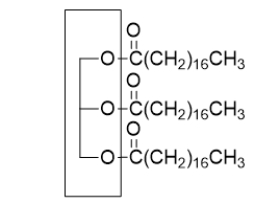
A) the amino acid backbone.
B) the glycerol backbone.
C) the phosphate backbone.
D) a saturated fatty acid.
E) an unsaturated fatty acid.

A) the amino acid backbone.
B) the glycerol backbone.
C) the phosphate backbone.
D) a saturated fatty acid.
E) an unsaturated fatty acid.

Unlock Deck
Unlock for access to all 106 flashcards in this deck.
Unlock Deck
k this deck
57
The component of a cell membrane shown below is 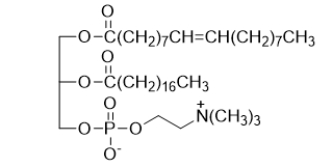
A) nonpolar.
B) a steroid.
C) amphipathic.
D) polar.
E) a lipoprotein.

A) nonpolar.
B) a steroid.
C) amphipathic.
D) polar.
E) a lipoprotein.

Unlock Deck
Unlock for access to all 106 flashcards in this deck.
Unlock Deck
k this deck
58
Which statement about cholesterol is FALSE?
A) It is used to synthesize steroid hormones.
B) It is a precursor for bile acids.
C) It adds rigidity to cell membranes.
D) It is a precursor of prostaglandins.
E) It is an amphipathic molecule.
A) It is used to synthesize steroid hormones.
B) It is a precursor for bile acids.
C) It adds rigidity to cell membranes.
D) It is a precursor of prostaglandins.
E) It is an amphipathic molecule.

Unlock Deck
Unlock for access to all 106 flashcards in this deck.
Unlock Deck
k this deck
59
While fats, proteins, and carbohydrates are all catabolized in similar biochemical pathways, fats present a problem that the other two nutrient types do not.Which choice is a problem with fat digestion that proteins and sugars do not have?
A) Fats are water soluble, and proteins and sugars are not.
B) Fats are highly reactive, and proteins and sugars are not.
C) Fats are not at all reactive, whereas proteins and sugars are very reactive.
D) Proteins and sugars are water soluble, but fats are not.
E) Fats are unusual because they do not interact with enzymes.
A) Fats are water soluble, and proteins and sugars are not.
B) Fats are highly reactive, and proteins and sugars are not.
C) Fats are not at all reactive, whereas proteins and sugars are very reactive.
D) Proteins and sugars are water soluble, but fats are not.
E) Fats are unusual because they do not interact with enzymes.

Unlock Deck
Unlock for access to all 106 flashcards in this deck.
Unlock Deck
k this deck
60
Both of these lipids are found in 
A) cell membranes.
B) mitochondria.
C) proteins.
D) steroids.
E) soap.

A) cell membranes.
B) mitochondria.
C) proteins.
D) steroids.
E) soap.

Unlock Deck
Unlock for access to all 106 flashcards in this deck.
Unlock Deck
k this deck
61
Where would you MOST likely find unsaturated fats?
A) They are found in meat.
B) They are found in cheese.
C) They are found in butter.
D) They are found in plants.
E) They are found in margarine.
A) They are found in meat.
B) They are found in cheese.
C) They are found in butter.
D) They are found in plants.
E) They are found in margarine.

Unlock Deck
Unlock for access to all 106 flashcards in this deck.
Unlock Deck
k this deck
62
How does a double bond in a fatty acid change the overall structure of the fatty acid?
A) The overall structure does not change.
B) The more double bonds a fatty acid has, the more linear it is.
C) The more double bonds a fatty acid has, the more flexible it is.
D) The more double bonds a fatty acid has, the more bent or kinked it is.
E) The more double bonds a fatty acid has, the more twisted it is.
A) The overall structure does not change.
B) The more double bonds a fatty acid has, the more linear it is.
C) The more double bonds a fatty acid has, the more flexible it is.
D) The more double bonds a fatty acid has, the more bent or kinked it is.
E) The more double bonds a fatty acid has, the more twisted it is.

Unlock Deck
Unlock for access to all 106 flashcards in this deck.
Unlock Deck
k this deck
63
The lipid is labeled A-D.Which of the labeled parts of this molecule comprise the sphingosine backbone? 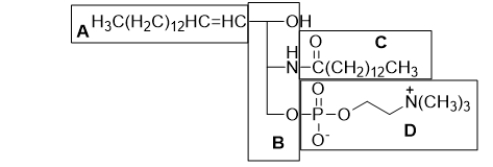
A) A only
B) A and B
C) B and C
D) A, B, and D
E) The sphingosine backbone is composed of all of the labeled parts of the molecule.

A) A only
B) A and B
C) B and C
D) A, B, and D
E) The sphingosine backbone is composed of all of the labeled parts of the molecule.

Unlock Deck
Unlock for access to all 106 flashcards in this deck.
Unlock Deck
k this deck
64
A triacylglycerol that is solid at room temperature is called a(n)
A) lipid.
B) oil.
C) eicosanoid.
D) steroid.
E) fat.
A) lipid.
B) oil.
C) eicosanoid.
D) steroid.
E) fat.

Unlock Deck
Unlock for access to all 106 flashcards in this deck.
Unlock Deck
k this deck
65
Which statement BEST describes why HDL is considered "good cholesterol"?
A) It has the highest density.
B) It is the smallest lipoprotein.
C) It scavenges excess cholesterol and takes it to the liver.
D) It takes triacylglycerols to adipocytes.
E) It converts cholesterol into bile salts.
A) It has the highest density.
B) It is the smallest lipoprotein.
C) It scavenges excess cholesterol and takes it to the liver.
D) It takes triacylglycerols to adipocytes.
E) It converts cholesterol into bile salts.

Unlock Deck
Unlock for access to all 106 flashcards in this deck.
Unlock Deck
k this deck
66
The type of molecules that make up the majority of the cell membrane are
A) phospholipids.
B) steroids.
C) transmembrane proteins.
D) carbohydrates.
E) cholesterol.
A) phospholipids.
B) steroids.
C) transmembrane proteins.
D) carbohydrates.
E) cholesterol.

Unlock Deck
Unlock for access to all 106 flashcards in this deck.
Unlock Deck
k this deck
67
Which disease is not typically treated with prostaglandin inhibitors?
A) asthma
B) pain and inflammation
C) bronchitis
D) glaucoma
E) cancer
A) asthma
B) pain and inflammation
C) bronchitis
D) glaucoma
E) cancer

Unlock Deck
Unlock for access to all 106 flashcards in this deck.
Unlock Deck
k this deck
68
Triacylglycerols generally have physical properties
A) similar to the fatty acids from which they are composed.
B) similar to glycerol.
C) very different from the fatty acids from which they are composed.
D) similar to phospholipids.
E) All lipids have the same physical properties.
A) similar to the fatty acids from which they are composed.
B) similar to glycerol.
C) very different from the fatty acids from which they are composed.
D) similar to phospholipids.
E) All lipids have the same physical properties.

Unlock Deck
Unlock for access to all 106 flashcards in this deck.
Unlock Deck
k this deck
69
This type of lipoprotein is often called "good cholesterol."
A) chylomicron
B) VLDL
C) IDL
D) LDL
E) HDL
A) chylomicron
B) VLDL
C) IDL
D) LDL
E) HDL

Unlock Deck
Unlock for access to all 106 flashcards in this deck.
Unlock Deck
k this deck
70
Which is the correct omega system numbers for arachidonic acid, CH3(CH2)4(CH=CHCH2)4(CH2)2CO2H?
A) omega-5,8,11,15
B) omega-5
C) omega-3
D) omega-6
E) omega-6,9,13,16
A) omega-5,8,11,15
B) omega-5
C) omega-3
D) omega-6
E) omega-6,9,13,16

Unlock Deck
Unlock for access to all 106 flashcards in this deck.
Unlock Deck
k this deck
71
Which statement describes lipids?
A) Lipids all have the steroid backbone.
B) The body stores excess calories as lipids.
C) Lipids are insoluble in water but soluble in nonpolar solvents.
D) Lipids are soluble in water but insoluble in nonpolar solvents.
E) Lipids are insoluble in all solvents.
A) Lipids all have the steroid backbone.
B) The body stores excess calories as lipids.
C) Lipids are insoluble in water but soluble in nonpolar solvents.
D) Lipids are soluble in water but insoluble in nonpolar solvents.
E) Lipids are insoluble in all solvents.

Unlock Deck
Unlock for access to all 106 flashcards in this deck.
Unlock Deck
k this deck
72
Triacylglycerols are not soluble in water and so cannot be transported through the blood without help.How are fats transported?
A) in lipoproteins
B) in starch
C) alongside hormones
D) through protein channels
E) They are not transported.
A) in lipoproteins
B) in starch
C) alongside hormones
D) through protein channels
E) They are not transported.

Unlock Deck
Unlock for access to all 106 flashcards in this deck.
Unlock Deck
k this deck
73
A patient sprained her knee in a game of basketball and presents with swelling and pain.Which statement BEST describes why the swelling occurs?
A) Leukotrienes make blood vessels more permeable, leading to the delivery of immune system cells to the damaged tissue.
B) Broken blood vessels bleed into the injured area, making it swell.
C) The increase in temperature by prostaglandins results in increased blood flow to the area.
D) Thromboxanes isolate the injured tissue, resulting in swelling.
E) All of the above describe why swelling occurs.
A) Leukotrienes make blood vessels more permeable, leading to the delivery of immune system cells to the damaged tissue.
B) Broken blood vessels bleed into the injured area, making it swell.
C) The increase in temperature by prostaglandins results in increased blood flow to the area.
D) Thromboxanes isolate the injured tissue, resulting in swelling.
E) All of the above describe why swelling occurs.

Unlock Deck
Unlock for access to all 106 flashcards in this deck.
Unlock Deck
k this deck
74
These steroid hormones control the menstrual cycle.
A) glucocorticoids
B) mineralocorticoids
C) progestins
D) androgens
E) estrogens
A) glucocorticoids
B) mineralocorticoids
C) progestins
D) androgens
E) estrogens

Unlock Deck
Unlock for access to all 106 flashcards in this deck.
Unlock Deck
k this deck
75
The component of the cell membrane labeled C corresponds to which part of the following glycerophospholipid? 
A) component 1
B) component 2
C) component 3
D) component 4
E) components 2 and 3

A) component 1
B) component 2
C) component 3
D) component 4
E) components 2 and 3

Unlock Deck
Unlock for access to all 106 flashcards in this deck.
Unlock Deck
k this deck
76
Which type of molecule is NOT a lipid?
A) amino acid
B) triacylglycerol
C) phospholipid
D) steroid
E) eicosanoid
A) amino acid
B) triacylglycerol
C) phospholipid
D) steroid
E) eicosanoid

Unlock Deck
Unlock for access to all 106 flashcards in this deck.
Unlock Deck
k this deck
77
Which of the following is an indicator of inflammation?
A) pain
B) swelling
C) warmth
D) redness
E) All of these are indicators of inflammation.
A) pain
B) swelling
C) warmth
D) redness
E) All of these are indicators of inflammation.

Unlock Deck
Unlock for access to all 106 flashcards in this deck.
Unlock Deck
k this deck
78
Which statement BEST describes the lipid bilayer?
A) It is flexible and fluid-like.
B) It is held together by hydrogen bonds.
C) It is rigid and stiff.
D) It cracks easily.
E) All of the above describe the lipid bilayer.
A) It is flexible and fluid-like.
B) It is held together by hydrogen bonds.
C) It is rigid and stiff.
D) It cracks easily.
E) All of the above describe the lipid bilayer.

Unlock Deck
Unlock for access to all 106 flashcards in this deck.
Unlock Deck
k this deck
79
Glycerophospholipids typically contain unsaturated fatty acids because they
A) act as receptors for steroids.
B) have few attractive forces between them, making the membrane fluid.
C) have many attractive forces between them, making the membrane fluid.
D) have few attractive forces between them, making the membrane stiff.
E) have many attractive forces between them, making the membrane stiff.
A) act as receptors for steroids.
B) have few attractive forces between them, making the membrane fluid.
C) have many attractive forces between them, making the membrane fluid.
D) have few attractive forces between them, making the membrane stiff.
E) have many attractive forces between them, making the membrane stiff.

Unlock Deck
Unlock for access to all 106 flashcards in this deck.
Unlock Deck
k this deck
80
In the following illustration of a cell membrane, the molecule that acts as a receptor, communicating with molecules such as steroids, is represented by the letter 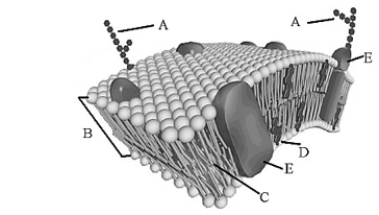
A) A
B) B
C) C
D) D
E) E

A) A
B) B
C) C
D) D
E) E

Unlock Deck
Unlock for access to all 106 flashcards in this deck.
Unlock Deck
k this deck



